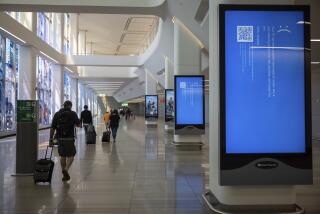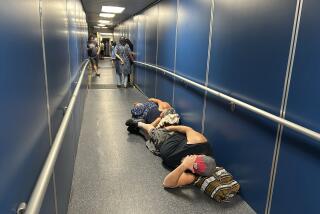Computer Bug Invades Systems Throughout U.S.
- Share via
A large-scale computer virus infected systems across the country Thursday, afflicting Lawrence Livermore National Laboratory and at least eight major universities, including UC San Diego, UC Berkeley, Stanford and Massachusetts Institute of Technology, but officials said they were unaware of any damage.
The bug infected hundreds of computers but apparently did not destroy any files or research, said Prof. James Bruce, vice president for information systems at MIT.
The New York Times in today’s editions said that unidentified computer security analysts were calling the virus “the largest assault ever on the nation’s computers.”
Viruses, the communicable diseases of computers, are tiny programs created in computers either as a joke or vandalism. They can attach themselves to other programs and spread through shared software.
In their mildest form, a message flashes on a user’s screen; as malignancies, they can destroy data and cripple a computer.
“We’re not crippled,” Bruce said. “It first showed up in the middle of the night and spread very virulently during the day.”
At the San Diego Super Computer Center on the campus of UCSD, the virus began showing up Wednesday night.
“It did in fact hit here. This morning is when I noticed it,” said Gerard Newman, a member of the technical staff at the center.
“It was benign in that it didn’t cause any damage. But it was incredibly prolific--it attempted to find as many computers as it could to infect. It slowed three systems here,” he said.
Although the supercomputers weren’t directly affected, Newman said, “for a while I had to shut down several of the connections to the various research networks in order to prevent the virus from propagating itself” in other support systems.
“It was definitely deliberate. Somebody turned this animal loose . . . “ Newman said.
The Super Computer Center is a National Science Foundation-sponsored research facility that is available to university researchers for scientific inquiry.
Also affected in the San Diego area was Qualcomm Inc., a satellite communications company in La Jolla.
The most worrisome invasion occurred at Livermore, one of two national labs where nuclear weapons are designed. Spokeswoman Bonnie Jean Barringer said the invasion “was detected and contained within two hours.”
Livermore spokesman Jeff Garberson said a computer problem was discovered late Wednesday.
“We . . . took action to contain it, which means to stop it from spreading to other computer systems. We were successful by about 1 in the morning,” about five hours after it was discovered.
“This is for unclassified, non-secured systems,” Garberson said. “It did not affect our classified national defense system at all.”
The lab’s work includes design of the nation’s nuclear weapons and key work on the Strategic Defense Initiative. “We are now powering back up and should have all these unclassified systems back on line by tomorrow,” Garberson said.
Wallace Raven, spokesman for UC Berkeley, called the virus “kind of nasty but not malicious.” He said it “ate up computer time,” causing the university system to slow down, but “there was no damage and nothing was lost.”
At 3 a.m. Thursday, university officials “posted a fix,” telling users how to protect the system from the virus.
The virus was reported to have made its way into sophisticated VAX and Sun computer systems at MIT, Stanford, Berkeley, Cornell University, Purdue University, the University of Wisconsin, Boston University and the University of Chicago.
Experts believe many other facilities, including Rutgers University and the University of Michigan, may also have been hit.
The virus is believed to have traveled between computer systems through a process in which computer operators exchange “electronic mail.”
Once the messages were received, they linked up to command controls and told the local computer to make copies of the virus. The copies then sought out other connected machinery.
In Washington, Charles Redmond, a spokesman for NASA, said there had been no reports of the space agency’s public computer system, Space Physics Analysis Network, or SPAN, being affected by the attack, but the system is linked to some of the infected networks.
“We are treating this seriously and alerting users on SPAN to protect their data and their programs. The system we have has in the past been the victim of viruses because it is deliberately maintained as an open system for international scientific participation,” Redmond said.
Al Thaler, program manager for the National Science Foundation’s NSFnet, was shaken by the invasion of the nation’s research computers. “It is a mean-spirited, vicious thing that interferes severely with the communications network our research computers live in. We are angry,” he said.
Even though it will be hard to find out who started the virus, Thaler said, “we are going to try.”
More to Read
Sign up for Essential California
The most important California stories and recommendations in your inbox every morning.
You may occasionally receive promotional content from the Los Angeles Times.









